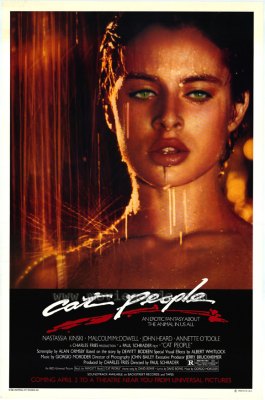| Reviews & Columns |
|
Reviews DVD TV on DVD Blu-ray 4K UHD International DVDs In Theaters Reviews by Studio Video Games Features Collector Series DVDs Easter Egg Database Interviews DVD Talk Radio Feature Articles Columns Anime Talk DVD Savant Horror DVDs The M.O.D. Squad Art House HD Talk Silent DVD
|
DVD Talk Forum |
|
|
| Resources |
|
DVD Price Search Customer Service #'s RCE Info Links |
|
Columns
|
|
|
Cat People (1982) (HD DVD)
Nastassja Kinski stars as Irena Gallier, a wide-eyed (literal) virgin who is reunited with her older, minister brother Paul (Malcolm McDowell) in New Orleans after many years. She had been in and out of foster homes after their animal-trainer, circus-folk parents died when they were children. From their first meeting Paul clearly has unhealthy, incestuous designs on Irena and, worse, Paul occasionally transforms into a black leopard. In an early scene in leopard form Paul mauls a prostitute but is captured the following morning by the curator of the New Orleans Zoo, Oliver Yates (John Heard).
Her brother missing, Irena is eventually drawn to the zoo, where for reasons not clear to her stands for hours in front of leopard-Paul's cage. Oliver, spotting Irena at the zoo long after closing time, becomes friendly with her and eventually they embark on a romance, this despite the fact that Oliver's old girlfriend, Alice (Annette O'Toole) works closely with him at the zoo. In the meantime Paul escapes and begins killing women while trying to reconcile his relationship with Irena.
Very early in the film it becomes clear that Irena is also a cat-person (were-cat?), that they are from an ancient incestuous race dating back centuries and that her parents, who committed suicide, were cat people themselves. Irena's sexual awakening coincides with an instinctive need to transform into a leopard state and kill, though she resists Paul's insistence that she can mate only with sibling cat people.
I saw Cat People only once before, more than a quarter-century ago when it was new, and back then I was disappointed that it wasn't more in keeping with the style of the original film. I had hoped that, watching it again with a better understanding of what the film is (and isn't) trying to accomplish, I'd appreciate it more than I did before, but my overall reaction remained pretty much unchanged. Indeed, about the only thing I vividly remembered about the picture was a gory early death scene, in which zoo worker Joe Creigh (Ed Begley Jr.) gets his arm ripped out of its socket by leopard-Paul. This would seem to be an early-'80s concession to the changing horror market and while admittedly shocking, Creigh's split-second personality shift from genial Joe to irritable, careless zookeeper goes jarringly unmotivated.
Cat People unwisely directly remakes several scenes from the original film without improving upon any of them, while at the same time it attempts to incorporate explicit transformation scenes that are totally at stylistic odds with the Lewton-Tourneur film. As in the original film, Annette O'Toole's third wheel character is menaced by Irena in leopard form, with Alice treading water in a darkened indoor pool as the unseen cat paces about in the darkness. It's not a bad scene, but the pacing is all wrong and there's no build-up. The original Cat People introduced the cinematic technique known as "buses": shock effects in which a sudden burst of noise is preceded by a few frames of an object (literally a bus in Cat People, hence the name) suddenly coming into frame. The same effect is attempted moments before the pool scene in the remake, but it's so badly done as to have no impact at all. Another reference to the original film, a chance meeting with another, unrelated cat person, is similarly botched, here treated so off-handedly as to practically go unnoticed.
Indeed Cat People, while occasionally gory, is not at all frightening or unsettling like the best Val Lewton set pieces still are, nor does the film have the poetry of several of those films. What it does offer are the same preoccupations as those found in other Paul Schrader scripts like Taxi Driver and especially Hardcore: religion, sexual taboos, "saving" souls in an apocalyptic environment, etc. Unfortunately, Schrader's strengths seem to be held in check for want of a commercial horror film. In one sense all of Schrader's usual concerns are present and they had a lot in common with the 1942 original going in, hence he probably seemed like a good match with the material, but the script doesn't put them front-and-center as perhaps they should have been.
Another problem is Nastassja Kinski. She looks exactly right but her performance is lacking (she has the same childlike voice as Mariel Hemingway) and the script offers little help; she's enigmatic but not engagingly mysterious like Simone Simon in the original picture. Kinski's similar role in the comparatively minor Hammer horror film To the Devil a Daughter (1976) is frankly better realized.
On the plus side, McDowell and Heard are both quite good, and it's hard to complain too strongly about a film that offers lingering nude scenes of Kinski and (especially) O'Toole, both extremely attractive women. John Bailey's cinematography is outstanding; he and Schrader make excellent use of primary colors while the New Orleans locations, with its French-influenced and early-20th century architecture and (seamlessly matched with Fernando Scarfiotti's attractive sets) are visually interesting. (Several locations that became famous after Hurricane Katrina are seen, too.) Legendary matte artist Albert Whitlock, credited with the film's optical effects, contributes paintings that are both exceptionally beautiful yet also believably realistic and which don't draw attention to themselves, not an easy task. Giorgio Moroder was Hot Stuff in the early-'80s for his synthesizer scores, but in the wake of countless imitative works in all manner of horror and suspense thrillers, it's lost a lot of its freshness and now is the film's most dated component.
Video & Audio
Cat People is a stunner in high-def. The prologue, set in Africa and bathed in red-orange light, is a knock-out. Old VHS versions of the sequence must have looked awful, but here is rendered perfectly. Also in this opening, audiences get their first glimpse of a black leopard, its midnight black coat among the blackest black this reviewer has seen in high-def so far. The rest of the film (1.85:1 in theaters, 1.78:1 on HD DVD) is somewhat more conventional, but the optical work suffers not at all at the splashes of primary colors here and there really jump off the screen. Shot using Panavision lenses and originally printed by Technicolor, the 1080p / VC-1 encoded / HD-30 gets high marks.
The audio, Dolby Stereo in 1982, has been remixed in Dolby TrueHD 5.1 and 5.1 Dolby Digital Plus (in English only, with optional French and hard-of-hearing English subtitles) and is limited in terms of its sound effects mix, and the dialogue track is unimpressive, but Moroder's score (and David Bowie's end title song) fare well.
Extra Features
Supplements, all in standard 480i/p, include several featurettes by Laurent Bouzereau. Cat People: An Intimate Portrait features a November 2000 interview with Schrader who talks about the film at some length and has interesting and frank things to say, such as an admission that the 1942 film "never meant much to me" and that he had wanted the movie credited as "A Paul Schrader and Fernando Scarfiotti Film," owing to the latter's substantial contributions. It makes a nice contrast with On the Set with Paul Schrader, in which the director in 1981 comes off as extraordinarily pretentious, rejecting the unseen interviewer's mostly intelligent remarks and questions. Schrader expands on his then-and-now comments in an audio commentary track.
Also included is a new featurette, Special Effects Makeup Effects by Tom Burman, Filmmaker Robert Wise on the Producer of the Original Cat People, Val Lewton, Cat People Matte Paintings (which look like they were culled from the type of demo reels used for Oscar consideration), Production Photographs and a dog-eared Trailer.
Parting Thoughts
An HD DVD exclusive, Cat People is a big disappointment, but the generally intelligent and adult approach to the material make it interesting. The transfer pictorially is terrific and the extras, while not high-def originals, are generally good. Recommended.
Film historian Stuart Galbraith IV's latest books, Japanese Cinema and The Toho Studios Story, are now available for pre-order.
|
| Popular Reviews |
| Sponsored Links |
|
|
| Sponsored Links |
|
|
| Release List | Reviews | Shop | Newsletter | Forum | DVD Giveaways | Blu-Ray | Advertise |
|
Copyright 2024 DVDTalk.com All Rights Reserved. Legal Info, Privacy Policy, Terms of Use,
Manage Preferences,
Your Privacy Choices | |||||||
















